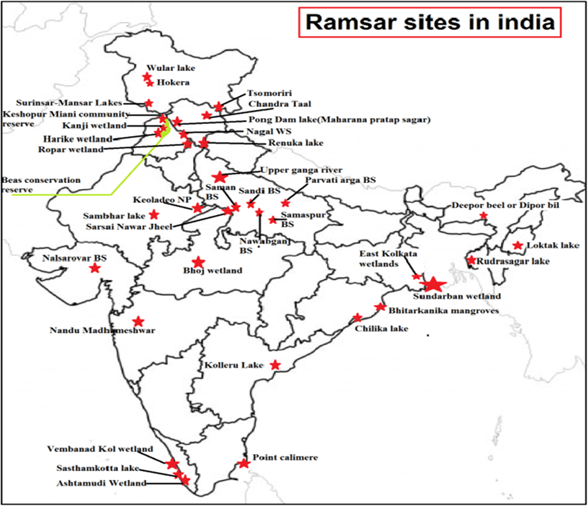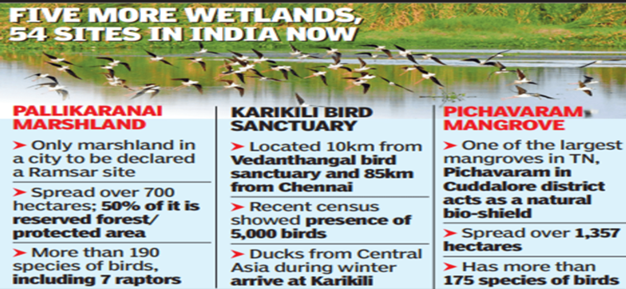In News:
- Union Government has designated five new wetlands of international importance, taking the total number of Ramsar sites in the country to 54.
What’s in today’s article:
- Ramsar Convention – About, Ramsar site, significance of Ramsar site designation, Ramsar sites in India
- News Summary
Ramsar Convention:
- The Ramsar Convention, signed in 1971 in Ramsar, Iran, is the only global treaty that focuses specifically on wetlands.
- It is an intergovernmental treaty for the conservation and wise use of wetlands.
- Objective: To halt the worldwide loss of wetlands and to conserve, through wise use and management, those that remain.
- Members: 170 countries are signatories to the convention.
- A contracting party agrees to nominate at least one wetland in its territory to the List of Wetlands of International Importance based on enumerated criteria.
Ramsar Site
- A Ramsar Site is a wetland site designated to be of international importance.
- Wetlands include swamps, marshes, lakes, mudflats, mangroves, coral reefs, fens, or bodies of water - whether natural or artificial, permanent or temporary.
- These wetlands are protected under strict guidelines of the Ramsar Convention on Wetlands.
- Ramsar convention defines wetlands as “areas of marsh, fen, peat land or water, whether natural or artificial, permanent or temporary, with water that is static or flowing, fresh, brackish or salt, including areas of marine water the depth of which at low tide does not exceed six meters.”
Significance of ‘Ramsar Site’ Designation:
- Once designated, these sites are added to the Convention's List of Wetlands of International Importance and become known as Ramsar sites.
- In designating a wetland as a Ramsar site, countries agree to establish and oversee a management framework aimed at conserving the wetland and ensuring its wise use.
- Wise use under the Convention is broadly defined as maintaining the ecological character of a wetland.
- Wetlands can be included on the List of Wetlands of International Importance because of their ecological, botanical, zoological, limnological or hydrological importance.
Ramsar Sites in India:

- India signed the Ramsar convention in February 1982.
- There are over 2,400 Ramsar Sites around the world covering over 2.5 million square kilometres.
- India’s tally of 49 (without including the recently designated 5 sites) designated wetlands spread over 10,936 sq. km in 18 states and two union territories is the largest network of Ramsar Sites in South Asia.
- United Kingdom (175) and Mexico (142) have the maximum Ramsar sites in the world.
News Summary:

- Union Government has designated five new wetlands of international importance, taking the total number of Ramsar sites in the country to 54.
- These are –
- Karikili Bird Sanctuary (Tamil Nadu)
- Pallikaranai Marsh Reserve Forest (Tamil Nadu)
- Pichavaram Mangrove (Tamil Nadu)
- Sakhya Sagar (Madhya Pradesh)
- Created from the Manier river in 1918, Sakhya Sagar is located near Madhav National Park in the Shivpuri district of Madhya Pradesh.
- Pala Wetland (Mizoram)
- According to the government of Mizoram, its geographical location falls under the Indo-Burma biodiversity hotspot.
- The lake is a major component of the Palak Wildlife Sanctuary.
- Pala wetland hosts several globally threatened species, such as sambar deer, Asiatic black bear, slow loris, and Hoolock gibbon.
- It also provides refuge and breeding ground for IUCN red-listed critically endangered species of animals.
- This includes yellow tortoise, Southeast Asian giant tortoise and black softshell turtle.









